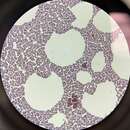pms
nòm ant ël fil


Staphylococcus xylosus е бактериски вид кој припаѓа на родот Staphylococcus. Станува збор за Грам-позитивна бактерија која формира кластери на клетки. Како и повеќето стафилококни видови, и овој вид е коагулаза-негативен и живее како коменсал на кожата на луѓето и животните.[1]
Staphylococcus xylosus може да се користи како CNC (коагулаза-негативни коки) во ферментацијата на салама.[2]
Се чини дека е многу повеќе чест кај животните отколку кај луѓето. Многу ретко се може да биде идентификуван како причинител на човечка инфекција.
Овој вид нормално е чувствителен на флероксацин, метицилин, пеницилин, теикопланин, еритромицин и тетрациклин, а резистентен е на новобиоцин. Биохемиски е многу активен, создавајќи органски киселини од разни јаглехидрати.
Способен е да продуцира киселина и гас од D-(+)-галактоза, D-(+)-маноза, D-(+)-манитол, малтоза и лактоза.
Може да продуцира слузи, но не и клеточни капсули. Оваа способност ја губи после субкултивирање. Пептидогликанот на клеточниот ѕид е сличен на L-Lys-Gly3-5 L-Ser0.6-1.5 типот кој се среќава воглавно кај човечките стафилококни видови.
Staphylococcus xylosus е член на кожната микрофлора на човекот и другите животни. Понекогаш е поврзан со:
Најден е во млекото, сирењето, и колбасите.
Staphylococcus xylosus е бактериски вид кој припаѓа на родот Staphylococcus. Станува збор за Грам-позитивна бактерија која формира кластери на клетки. Како и повеќето стафилококни видови, и овој вид е коагулаза-негативен и живее како коменсал на кожата на луѓето и животните.
Staphylococcus xylosus може да се користи како CNC (коагулаза-негативни коки) во ферментацијата на салама.
Се чини дека е многу повеќе чест кај животните отколку кај луѓето. Многу ретко се може да биде идентификуван како причинител на човечка инфекција.
Staphylococcus xylosus is a species of bacteria belonging to the genus Staphylococcus. It is a Gram-positive bacterium that forms clusters of cells. Like most staphylococcal species, it is coagulase-negative and exists as a commensal on the skin of humans and animals and in the environment.[1]
Staphylococcus xylosus may be used as CNC (coagulase-negative cocci) in salami fermentation.[2]
It appears to be far more common in animals than in humans. S. xylosus has very occasionally been identified as a cause of human infection, but in some cases it may have been misidentified.
Staphylococcus xylosus is normally sensitive to fleroxacin, methicillin, penicillin, teicoplanin, erythromycin and tetracycline, and resistant to novobiocin. It is highly active biochemically, producing acid from a wide variety of carbohydrates.
Acid and gas are produced from D-(+)-galactose, D-(+)-mannose, D-(+)-mannitol, maltose, and lactose. Caseinolytic and gelatinase activities are normally present.
It normally produces slime but not capsules. This ability is lost upon subculture. Its cell wall peptidoglycan is similar to the L-Lys-Gly3-5 L-Ser0.6-1.5 type found in predominantly human species.
Staphylococcus xylosus is a member of the skin flora of humans and other animals. It has been associated with:
It is also found in milk, cheese, and sausage.
Staphylococcus xylosus is a species of bacteria belonging to the genus Staphylococcus. It is a Gram-positive bacterium that forms clusters of cells. Like most staphylococcal species, it is coagulase-negative and exists as a commensal on the skin of humans and animals and in the environment.
Staphylococcus xylosus may be used as CNC (coagulase-negative cocci) in salami fermentation.
It appears to be far more common in animals than in humans. S. xylosus has very occasionally been identified as a cause of human infection, but in some cases it may have been misidentified.
Le Staphylococcus xylosus une espèce de bactéries appartenant au genre Staphylococcus. Il s'agit d'une bactérie Gram-positive qui forme des grappes de cellules. Comme la plupart des espèces staphylococciques, il est coagulase-négatif et existe comme un commensal sur la peau des humains et des animaux et dans l'environnement[2]. Il semble être beaucoup plus fréquent chez les animaux que chez les humains. S. xylosus a été très occasionnellement identifié comme une cause d'infection humaine, mais dans certains cas il peut avoir été mal identifié.
Cette infection peut avoir bien d'autres formes que celle-ci.
Staphylococcus xylosus est un membre de la flore cutanée des humains et d'autres animaux. Il a été associé à :
Selon NCBI (11 novembre 2021)[3] :
Le Staphylococcus xylosus une espèce de bactéries appartenant au genre Staphylococcus. Il s'agit d'une bactérie Gram-positive qui forme des grappes de cellules. Comme la plupart des espèces staphylococciques, il est coagulase-négatif et existe comme un commensal sur la peau des humains et des animaux et dans l'environnement. Il semble être beaucoup plus fréquent chez les animaux que chez les humains. S. xylosus a été très occasionnellement identifié comme une cause d'infection humaine, mais dans certains cas il peut avoir été mal identifié.
Cette infection peut avoir bien d'autres formes que celle-ci.
Lo Staphylococcus xylosus è un batterio appartenente alla famiglia delle Staphylococcaceae, genere Staphylococcus, cocco disposto in gruppi irregolari, Gram positivo, a basso contenuto in G + C, fortemente alotollerante, con diametro cellulare da 0,5 a 1,5 µm, cresce in un range molto ampio di temperatura (da 8 a 45 °C), aerobio o anaerobio facoltativo, novobicina resistente, coagulasi negativo, in grado di moltiplicarsi in matrici con pH superiore a 4,5, ha forte attività nitrato reduttasica, proteolitica e lipolitica. Le condizioni ottimali di crescita sono: Aw 0,98, 32 °C di temperatura e concentrazione salina di 0,4 - 0,6M.
La presenza di questo microrganismo è documentata in moltissimi salami di ogni parte del mondo, e spesso è utilizzato proprio come starter per la produzione di questi alimenti, in quanto svolge molteplici attività metaboliche che si ripercuotono sulla qualità e sicurezza del prodotto finito.